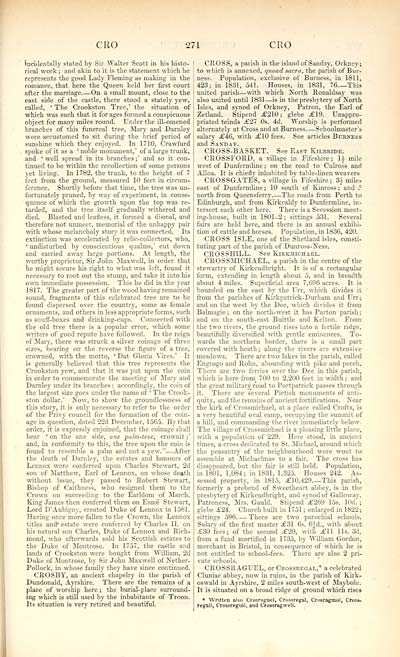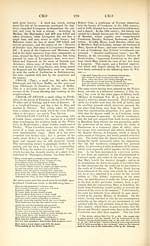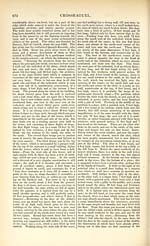Topographical, statistical, and historical gazetteer of Scotland > Volume 1
(353) Page 271
Download files
Complete book:
Individual page:
Thumbnail gallery: Grid view | List view

CRO
271
CRO
incidentally stated by Sir Walter Scott in his histo-
rical work ; and akin to it is the statement which he
represents the good Lady Fleming as making in the
romance, that here the Queen held her first court
after the marriage On a small mount, close to the
east side of the castle, there stood a stately yew,
called, ' The Crookston Tree,' the situation of
which was such that it for ages formed a conspicuous
object for many miles round. Under the ill-omened
branches of this funereal tree, Mary and Darnley
were accustomed to sit during the brief period of
sunshine which they enjoyed. In 1710, Crawfurd
spoke of it as a 'noble monument,' of a large trunk,
and ' well spread in its branches ;' and so it con-
tinued to be within the recollection of some persons
yet living. In 1782, the trunk, to the height of 7
feet from the ground, measured 10 feet in circum-
ference. Shortly before that time, the tree was un-
fortunately pruned, by way of experiment, in conse-
quence of which the growth upon the top was re-
tarded, and the tree itself gradually withered and
died. Blasted and leafless, it formed a dismal, and
therefore not unmeet, memorial of the unhappy pair
with whose melancholy story it was connected. Its
extinction was accelerated by relic-collectors, who,
' undisturbed by conscientious qualms,' cut down
and carried away large portions. At length, the
worthy proprietor, Sir John Maxwell, in order that
he might secure his right to what was left, found it
necessary to root out the stump, and take it into his
own immediate possession. This he did in the year
1S17. The greater part of the wood having remained
sound, fragments of this celebrated tree are to be
found dispersed over the country, some as female
ornaments, and others in less appropriate forms, such
as snuff-boxes and drinking-cups. Connected with
the old tree there is a popular error, which some
Writers of good repute have followed. In the reign
of Mary, there was struck a silver coinage of three
sizes, bearing on the reverse the figure of a tree,
crowned, with the motto, ' Dat Gloria Vires.' It
is generally believed that this tree represents the
Crookston yew, and that it was put upon the coin
in order to commemorate the meeting of Mary and
Darnley under its branches : accordingly, the coin of
the largest size goes under the name of * The Crook-
ston dollar.' Now, to show the groundlessness of
this story, it is only necessary to refer to the order
of the Privy council for the formation of the coin-
age in question, dated 22d December, 1565. By that
order, it is expressly enjoined, that the coinage shall
bear ' on the ane side, ane palm-tree, crownit ;'
and, in conformity to this, the tree upon the coin is
found to resemble a palm and not a yew." — After
the death of Darnley, the estates and honours of
Lennox were conferred upon Charles Stewart, 2d
son of Matthew, Earl of Lennox, on whose death
without issue, they passed to Robert Stewart,
Bishop of Caithness, who resigned them to the
Crown on succeeding to the Earldom of March.
King James then conferred them on Esme Stewart,
Lord D'Aubigny, created Duke of Lennox in 1581.
Having once more fallen to the Crown, the Lennox
titles and* estate were conferred by Charles II. on
bis natural son Charles, Duke of Lennox and Rich-
mond, who afterwards sold his Scottish estates to
the Duke of Montrose. In 1757, the castle and
lands of Crookston were bought from William, 2d
Duke of Montrose, by Sir John Maxwell of Nether-
Pollock, in whose family they have since continued.
CROSBY, an ancient chapelry in the parish of
Dundonald, Ayrshire. There are the remains of a
place of worship here ; the burial-place surround-
ing which is still used by the inhabitants of Troon.
Its situation is verv retired and beautiful.
CROSS, a parish in the island of Sanday, Orkney;
to which is annexed, quoad sacra, the parish of Bur-
ness. Population, exclusive of Burness, in 1811,
423; in 1831, 541. Houses, in 1831, 76 This
united parish — with which North Ronaldsay was
also united until 1831 — is in the presbytery of North
Isles, and synod of Orkney, Patron, the Earl of
Zetland. Stipend £210 ; glebe £19. Unappro-
priated teinds £27 0s. 4d. Worship is performed
alternately at Cross and at Burness Schoolmaster's
salary £46, with £10 fees. See articles Bcbntsss
and Sanday.
CROSS-BASKET. See East Kilbride.
CROSSFORD, a village in Fifeshire ; U mile
west of Dunfermline ; on the road to Culross and
Alloa. It is chieflv inhabited bv table-linen weavers
CROSSGATES, a village in Fifeshire; 3A miles
east of Dunfermline ; 10 south of Kinross ; and 5
north from Queensferry The roads from Perth to
Edinburgh, and from Kirkcaldy to Dunfermline, in-
tersect each other here. There is a Secession meet-
ing-house, built in 1801-2 ; sittings 531 . Several
fairs are held here, and there is an annual exhibi-
tion of cattle and horses. Population, in 1836, 420.
CROSS ISLE, one of the Shetland isles, consti-
tuting part of the parish of Dunross-Ness.
CROSSHILL. See Kirkmichael.
CROSSMICHAEL, a parish in the centre of the
stewartry of Kirkcudbright. It is of a rectangular
form, extending in length about 5, and in breadth
about 4 miles. Superficial area 7,696 acres. It is
bounded on the east by the Urr, which divides it
from the parishes of Kirkpatrick-Durham and Urr;
and on the west by the Dee, which divides it from
Balmagie; on the north-west it has Parton parish;
and on the south-east Buittle and Kelton. From
the two rivers, the ground rises into a fertile ridge,
beautifully diversified with gentle eminences. To-
wards the northern border, there is a small part
covered with heath ; along the rivers are extensive
meadows. There are two lakes in the parish, called
Engrogo and Rohn, abounding with pike and perch.
There are two ferries over the Dee in this parish,
which is here from 700 to 2,200 feet in width ; and
the great military^ road to Portpatrick passes through
it. There are several Pictish monuments of anti-
quity, and the remains of ancient fortifications. Near
the kirk of Crossmichael, at a place called Crofts, is
a very beautiful oval camp, occupying the summit of
a hill, and commanding the river immediately below.
The village of Crossmichael is a pleasing little place,
with a population of 229. Here stood, in ancient
times, a cross dedicated to St. Michael, around which
the peasantry of the neighbourhood were wont to
assemble at Michaelmas to a fair. The cross has
disappeared, but the fair is still held. Population,
in 1801, 1,084; in 1831, 1,325. Houses 242. As-
sessed property, in 1815, £10,429 This parish,
formerly a prebend of Sweetheart abbey, is in the
presbytery of Kirkcudbright, and svnod of Galloway.
Patroness, Mrs. Gauld. Stipend "£269 1.5s. lOd. ;
glebe £24. Church built in 1751 ; enlarged in 1822;
sittings 596. — There are two parochial schools.
Salarv of the first master £31 6s. 6Jd., with about
£30 fees; of the second £20, with £11 lis. 3d.
from a fund mortified in 1735, by William Gordon,
merchant in Bristol, in consequence of which he is
not entitled to school-fees. There are also 2 pri-
vate schools.
CROSSRAGUEL, or Crossregal,* a celebrated
Cluniae abbey, now in ruins, in the parish of Kirk-
oswald in Ayrshire, 2 miles south-west of Maybole.
It is situated on a broad ridge of ground which rises
* Written also Crosragnel, Crossregal, Crosragmol, Crosa-
regall, Crossreguil, and CroBsragwell.
271
CRO
incidentally stated by Sir Walter Scott in his histo-
rical work ; and akin to it is the statement which he
represents the good Lady Fleming as making in the
romance, that here the Queen held her first court
after the marriage On a small mount, close to the
east side of the castle, there stood a stately yew,
called, ' The Crookston Tree,' the situation of
which was such that it for ages formed a conspicuous
object for many miles round. Under the ill-omened
branches of this funereal tree, Mary and Darnley
were accustomed to sit during the brief period of
sunshine which they enjoyed. In 1710, Crawfurd
spoke of it as a 'noble monument,' of a large trunk,
and ' well spread in its branches ;' and so it con-
tinued to be within the recollection of some persons
yet living. In 1782, the trunk, to the height of 7
feet from the ground, measured 10 feet in circum-
ference. Shortly before that time, the tree was un-
fortunately pruned, by way of experiment, in conse-
quence of which the growth upon the top was re-
tarded, and the tree itself gradually withered and
died. Blasted and leafless, it formed a dismal, and
therefore not unmeet, memorial of the unhappy pair
with whose melancholy story it was connected. Its
extinction was accelerated by relic-collectors, who,
' undisturbed by conscientious qualms,' cut down
and carried away large portions. At length, the
worthy proprietor, Sir John Maxwell, in order that
he might secure his right to what was left, found it
necessary to root out the stump, and take it into his
own immediate possession. This he did in the year
1S17. The greater part of the wood having remained
sound, fragments of this celebrated tree are to be
found dispersed over the country, some as female
ornaments, and others in less appropriate forms, such
as snuff-boxes and drinking-cups. Connected with
the old tree there is a popular error, which some
Writers of good repute have followed. In the reign
of Mary, there was struck a silver coinage of three
sizes, bearing on the reverse the figure of a tree,
crowned, with the motto, ' Dat Gloria Vires.' It
is generally believed that this tree represents the
Crookston yew, and that it was put upon the coin
in order to commemorate the meeting of Mary and
Darnley under its branches : accordingly, the coin of
the largest size goes under the name of * The Crook-
ston dollar.' Now, to show the groundlessness of
this story, it is only necessary to refer to the order
of the Privy council for the formation of the coin-
age in question, dated 22d December, 1565. By that
order, it is expressly enjoined, that the coinage shall
bear ' on the ane side, ane palm-tree, crownit ;'
and, in conformity to this, the tree upon the coin is
found to resemble a palm and not a yew." — After
the death of Darnley, the estates and honours of
Lennox were conferred upon Charles Stewart, 2d
son of Matthew, Earl of Lennox, on whose death
without issue, they passed to Robert Stewart,
Bishop of Caithness, who resigned them to the
Crown on succeeding to the Earldom of March.
King James then conferred them on Esme Stewart,
Lord D'Aubigny, created Duke of Lennox in 1581.
Having once more fallen to the Crown, the Lennox
titles and* estate were conferred by Charles II. on
bis natural son Charles, Duke of Lennox and Rich-
mond, who afterwards sold his Scottish estates to
the Duke of Montrose. In 1757, the castle and
lands of Crookston were bought from William, 2d
Duke of Montrose, by Sir John Maxwell of Nether-
Pollock, in whose family they have since continued.
CROSBY, an ancient chapelry in the parish of
Dundonald, Ayrshire. There are the remains of a
place of worship here ; the burial-place surround-
ing which is still used by the inhabitants of Troon.
Its situation is verv retired and beautiful.
CROSS, a parish in the island of Sanday, Orkney;
to which is annexed, quoad sacra, the parish of Bur-
ness. Population, exclusive of Burness, in 1811,
423; in 1831, 541. Houses, in 1831, 76 This
united parish — with which North Ronaldsay was
also united until 1831 — is in the presbytery of North
Isles, and synod of Orkney, Patron, the Earl of
Zetland. Stipend £210 ; glebe £19. Unappro-
priated teinds £27 0s. 4d. Worship is performed
alternately at Cross and at Burness Schoolmaster's
salary £46, with £10 fees. See articles Bcbntsss
and Sanday.
CROSS-BASKET. See East Kilbride.
CROSSFORD, a village in Fifeshire ; U mile
west of Dunfermline ; on the road to Culross and
Alloa. It is chieflv inhabited bv table-linen weavers
CROSSGATES, a village in Fifeshire; 3A miles
east of Dunfermline ; 10 south of Kinross ; and 5
north from Queensferry The roads from Perth to
Edinburgh, and from Kirkcaldy to Dunfermline, in-
tersect each other here. There is a Secession meet-
ing-house, built in 1801-2 ; sittings 531 . Several
fairs are held here, and there is an annual exhibi-
tion of cattle and horses. Population, in 1836, 420.
CROSS ISLE, one of the Shetland isles, consti-
tuting part of the parish of Dunross-Ness.
CROSSHILL. See Kirkmichael.
CROSSMICHAEL, a parish in the centre of the
stewartry of Kirkcudbright. It is of a rectangular
form, extending in length about 5, and in breadth
about 4 miles. Superficial area 7,696 acres. It is
bounded on the east by the Urr, which divides it
from the parishes of Kirkpatrick-Durham and Urr;
and on the west by the Dee, which divides it from
Balmagie; on the north-west it has Parton parish;
and on the south-east Buittle and Kelton. From
the two rivers, the ground rises into a fertile ridge,
beautifully diversified with gentle eminences. To-
wards the northern border, there is a small part
covered with heath ; along the rivers are extensive
meadows. There are two lakes in the parish, called
Engrogo and Rohn, abounding with pike and perch.
There are two ferries over the Dee in this parish,
which is here from 700 to 2,200 feet in width ; and
the great military^ road to Portpatrick passes through
it. There are several Pictish monuments of anti-
quity, and the remains of ancient fortifications. Near
the kirk of Crossmichael, at a place called Crofts, is
a very beautiful oval camp, occupying the summit of
a hill, and commanding the river immediately below.
The village of Crossmichael is a pleasing little place,
with a population of 229. Here stood, in ancient
times, a cross dedicated to St. Michael, around which
the peasantry of the neighbourhood were wont to
assemble at Michaelmas to a fair. The cross has
disappeared, but the fair is still held. Population,
in 1801, 1,084; in 1831, 1,325. Houses 242. As-
sessed property, in 1815, £10,429 This parish,
formerly a prebend of Sweetheart abbey, is in the
presbytery of Kirkcudbright, and svnod of Galloway.
Patroness, Mrs. Gauld. Stipend "£269 1.5s. lOd. ;
glebe £24. Church built in 1751 ; enlarged in 1822;
sittings 596. — There are two parochial schools.
Salarv of the first master £31 6s. 6Jd., with about
£30 fees; of the second £20, with £11 lis. 3d.
from a fund mortified in 1735, by William Gordon,
merchant in Bristol, in consequence of which he is
not entitled to school-fees. There are also 2 pri-
vate schools.
CROSSRAGUEL, or Crossregal,* a celebrated
Cluniae abbey, now in ruins, in the parish of Kirk-
oswald in Ayrshire, 2 miles south-west of Maybole.
It is situated on a broad ridge of ground which rises
* Written also Crosragnel, Crossregal, Crosragmol, Crosa-
regall, Crossreguil, and CroBsragwell.
Set display mode to: Large image | Transcription
Images and transcriptions on this page, including medium image downloads, may be used under the Creative Commons Attribution 4.0 International Licence unless otherwise stated. ![]()
| Gazetteers of Scotland, 1803-1901 > Topographical, statistical, and historical gazetteer of Scotland > Volume 1 > (353) Page 271 |
|---|
| Permanent URL | https://digital.nls.uk/97441782 |
|---|
| Description | Volume first. A-H. |
|---|---|
| Attribution and copyright: |
|

